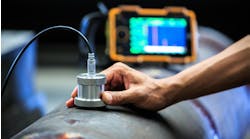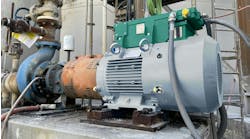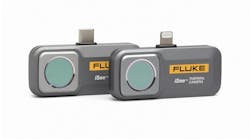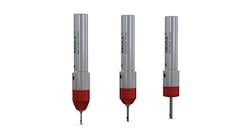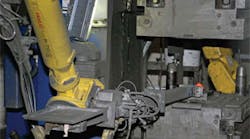Located near the Glasgow Airport in Scotland, Rolls-Royce Inchinnan produces gas turbine compressor airfoils, forging every element from billet to the finished product. The plant adopted a FANUC Robotics robot to automate a range of essential tasks in its operation, having been convinced the equipment could endure the hot, gritty, and stressful work environment. The robot performed well — consistently maintaining press-to-press times and heat transfer, accurately spraying die-lubricant (coverage and volume), and effectively applying a powdered glass coating lubricant to the completed forgings.
However, to lower operating costs and to eliminate more process variables, a plan was developed for an integrated system that would automate the entire production process with robotics. The plan was approved on the strength of Rolls- Royce’s “right first time” objectives — to reduce scrap and double throughput over a 24 X 5 production schedule.
During project development, planners realized that at the start of each shift an operator would perform as well as the robot, but the effect of standing in front of a 1,000°C oven, as well as the repetitive actions, took a toll on tack times: Ultimately, those factors resulted in an output by the robot that is double what the operator might accomplish.
Rolls-Royce asked FANUC Robotics to propose an automated process and to develop simulations for the manufacturer to analyze.
Simulations showed that each system would be comprised of two key stages in the forging process: pre-forming and final forming. The necessary equipment was designed, supplied, and integrated by FANUC Robotics UK Ltd. with control of all individual operations and overall system control managed by FANUC robot controllers.
Realizing “right first time”
Now, the fully automated forging program begins with loaded trays of pre-lubricated billets as they enter the first stage on a conveyor. The FANUC M-710iC/50 robot picks up individual billets and places them into a furnace, which indexes and presents a hot billet to be removed.
The hot billet is then placed in the first die position of a press and the robot releases the billet, signaling the press to begin its production cycle. When the cycle is complete, the press opens, and the robot clamps the sprue and positions the forging into the second die position, again releasing the sprue so that the press cycle can complete. Upon cycle completion, the robot picks up the forging and places it into a pick-up station for the next operation: shot blasting.
After the forging is released from pre-forming, a smaller robot (LR Mate 200iC) positions around the back of the press tool, blowing off debris from the redesigned tooling process, which ensures the forging is retained in the bottom die. After the debris is removed, a spray lubricant — DAG, or graphite release lubricant — is applied before the next cycle begins. The DAG operation is critical to consistent product quality as excess graphite in the tool can affect the form of the forging. Automating DAG application also ensures a consistent application. (A later addition is the spray application after every five cycles of dry ice granules, which has been found to be highly effective for removing in-process build-up of DAG.)
The shotblasting process is managed by a M-20iA robot, which picks up the forging and places it under two nozzles that blast sand to clean it. Upon cycle completion, the robot places the billet on an indexing conveyor that delivers it to the next stage: final forming.
Inverted and mounted on a three-meter linear axis, the M-710iC robot positions the forging within the final forming cell and begins electrostatic application of glassing, or release lubricant. The team from Rolls-Royce realized that applying glassing electrostatically eliminates variables associated with manual glassing and supported the objective of process consistency.
After glassing is completed, the M-710iC takes the forging to the furnace and places it into an indexer, removing the hot forging ready for final forming. The hot forging is placed in the cell where final forming takes place and the press cycle begins. When the cycle is complete, the forging is removed from the cell. Once again, the smaller LR Mate robot is critical at this point to achieving process consistency, applying DAG automatically after each cycle, with the dry-ice spray applied after several cycles.
The final product — a formed airfoil — is placed into a clipping press by the M-710iC robot and then placed onto a conveyor where it travels through a soaking tunnel. At the exit side of the furnace, a FANUC IR Vision system feeds positioning information to another M-710iC robot, which picks up the aerofoil and places it into a tray. When 100 aerofoils have been palletized, the full tray is picked up by the robot and positions into a collection stack to complete the operation.
Capacity doubled, consistency achieved
Rolls-Royce reports significant benefits from the new system, including improved efficiency, doubled capacity, improved quality, and a reduction in proces scrap. In addition to producing a more consistent product, the shop notes that less post-forging work is needed to finish each aerofoil. By removing variables from its multi-stage forging process Rolls-Royce is able to produce parts with a high-quality finish, such that only a sandblasting is required to finish them.
